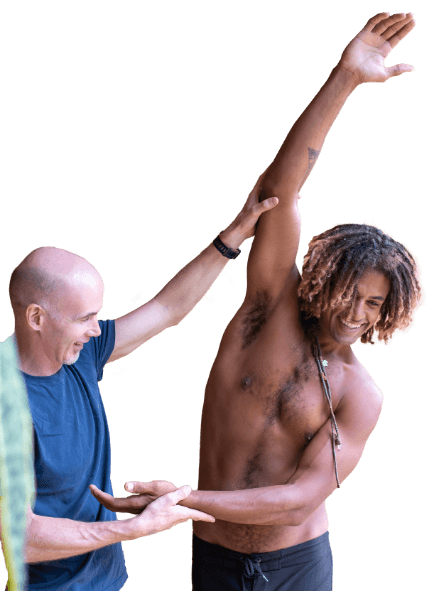
Many people ask us how osteopathic therapy is different from physiotherapy, chiropractic care, or massage.
The answer to that question doesn’t neatly fit into one line.
Let’s start with the similarities:
Osteopathic therapy, physiotherapy, chiropractic care, and massage share a common philosophy: The integrity of the spine is important in ensuring good health.
In fact, this philosophy is shared by almost all traditional healing arts, including yoga, tai chi, and chi gong. It is also found in many modern complementary and alternative treatment modalities, including Alexander Technique and Structural Integration, which is also known as Rolfing. The way some chiropractors and physiotherapists practice is very similar to the way osteopaths practice and visa versa. So, I’m going to make some generalities here, and that may upset some folks, but if you are good at what you do there is no need to take offense, just continue doing what you do and do it well.
Now for the differences:
Generally, people are motivated to seek a therapist because of pain or impaired movement. Let’s look at how different types of therapists might treat the same problem.
Imagine you have a shoulder injury. You play recreational golf, and each year, at the beginning of the season, you get a twinge in your shoulder. You’d like to play golf pain-free, and you’d like the pain dealt with once and for all.
You try physiotherapy . . .
- Your treatment time will vary from 15 to 30 minutes.
- The physiotherapist assesses your shoulder using standard orthopedic tests and reaches the conclusion that there is some impingement of one of the rotator cuff muscles, which is a very common shoulder injury.
- The therapist might choose to use some ultrasound on your shoulder.
- You will get some specific exercises to increase strength to any weakened muscles of your shoulder.
- The treatment may or may not include hands-on work. If it does, it will probably just be focused on your shoulder or upper ribs.
- You are asked to come back twice a week for eight treatments.
You try chiropractic care . . .
- Your treatment time will vary from 5 to 30 minutes for your first appointment and, in some cases, just last for about 5 minutes in subsequent sessions.
- Like the physiotherapist, the chiropractor might assess your shoulder using some standard orthopedic tests. The tests might also include an assessment of your spine, often using X-rays.
- The chiropractor will examine the parts of your spine where the nerves to the shoulder come out, checking for what they call a subluxation. From the chiropractor’s perspective, the spine can become minutely out of alignment, and the resulting subluxations inhibit nerve flow, which can cause joints to become injured.
- Treatment will probably involve manipulating your spine to free up the nerves so that they can better control your shoulder.
- You may then be asked to come back two to three times a week for three weeks. This can be a prepaid treatment plan or pay-as-you-go. You will then slowly decrease the frequency of your treatments until you are on some sort of monthly maintenance program to check for general subluxations.
You come to try osteopathic therapy with me. . .
- Your first treatment lasts one hour. Subsequent treatments last 30-45 minutes.
- I will assess your shoulder to find out which areas are damaged.
- I then assess your spine to see if the nerves in your shoulder are compromised. In this way, we are similar to chiropractors.
But here is where it gets interesting.
I will also look further afield because your shoulder does not work in isolation:
- I assess the quality of movement around some of your internal organs pertinent to your shoulder, including your lungs, liver, and gall bladder. Amazingly, the liver and gall bladder can both cause shoulder pain via a miscommunication in the spine that overlaps nerve feedback from both the shoulder and these organs.
- I assess other joints that work in conjunction with the shoulder, especially the wrists, elbows, neck, and hips.
- I might even choose to look at movement patterns. For example, I’d ask you to demonstrate your golf swing technique to see if any restrictions in your hips or neck are placing too much work on your shoulder.
The treatment is both hands-on and movement-based.
- The hands of an osteopathic therapist are more sensitive and knowledgeable than any type of machine. We don’t use ultrasound or any other devices to help us understand what’s going on.
- We find we get the best results by keeping the treatment to the work of our trained hands.
- We are trained to do strong manipulations, joint movements, and massage techniques.
- We also know how to use our hands in a very subtle way to gently free restrictions around organs and other deep body structures to restore health to your body as a whole.
The course of treatment with osteopathic therapy
- We might ask you back in one or two weeks.
- On average, we will want to see you four to six more times over a two—to three-month period to ensure the problem goes away.
- That will also give us a chance to help you with any other problems we may find that we think will cause you trouble in the future.
What other people say about the differences between manual therapists:




